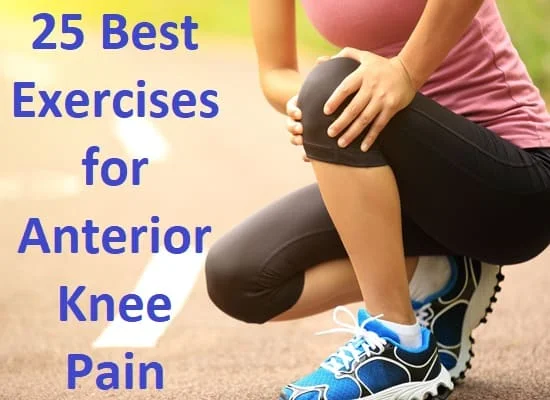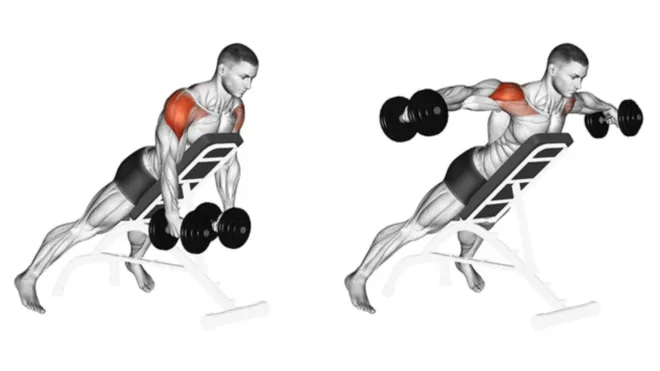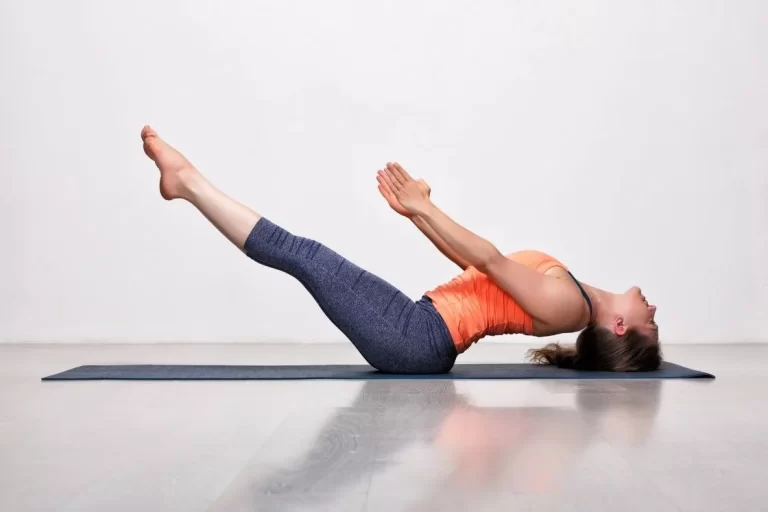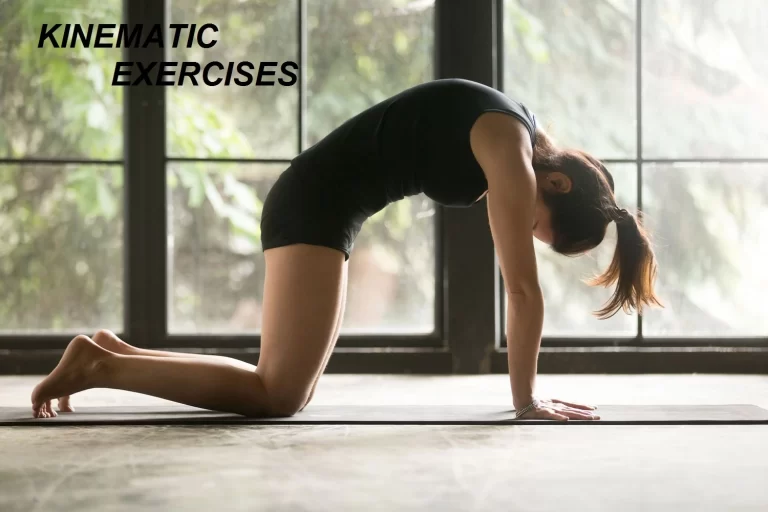25 Best Exercises for Anterior Knee Pain
Introduction:
Exercises for Anterior Knee Pain is an essential part of your overall treatment program along with Pain medication, Rest, and Avoiding activities, and exercises which are painful.
The greatest method to avoid injury is to have strong, flexible muscles and joints that can withstand tension and injury. Certain movements may both alleviate some pain in some mild cases of knee pain episodes. Never engage in any workout that causes pain. gentle stretching and strengthening activities may help reduce the anterior knee pain while enhancing your flexibility and range of motion if your knee pain is brought on by an injury, surgery, or arthritis.
Pain at the front of the knee is a typical complaint. Patellofemoral pain syndrome, runner’s knee, jumper’s knee, or patellar tendinitis are all names for anterior knee pain. This includes jumping, squatting, rising from a chair, and traversing the stairs. Swelling and a feeling of instability may or may not exist. Pain is typically a dull aching that worsens with the wrong exercise.
There are thousands of exercises available to strengthen the knee and surrounding joints. Physiotherapy will identify the primary “contributory factors” and deliver precise, focused workouts and muscle activity re-education in the correct sequence for the core, glutes, and quadriceps.
Exercises that strengthen the quadriceps muscles without putting pressure on the patella are essential for treating and preventing the recurrence of anterior knee discomfort. Gentle stretching will help to support your knee joint. Greater muscle strength assists in the movement of your knee joint by decreasing strain and strain.
Whenever beginning an exercise program for knee discomfort, consult with a doctor or physical therapist to check that the activities are appropriate for you. Depending on your situation, they may suggest some changes or physical therapy- a supervised workout program.
Exercise has the following benefits for anterior knee pain:
Below are some benefits of regular exercise.
- Enhances daily exercise performance
- Muscle relaxation & Muscle improvement
- Reduce discomforts
- Boost the joint’s capability of movement.
- Relieve the tightness of joints
- Improve your movement.
- Increase your adaptability.
- This contributes to the development of stronger weak muscles.
- Relax any tenseness
- Exercise can help you regain mobility.
- Enhancing coordination.
- Improve your equilibrium.
- Improved physical condition
The most efficient exercise for anterior knee discomfort is:
Listed below are the greatest exercise routines for treating anterior knee pain
Pillow push
- Begin by lying in a relaxed supine position on your bed.
- Place a pillow on one side of your knee joint.
- Simply press your back knee against the pillow.
- Maintain this posture for a few seconds.
- Return to your neutral position after that.
- Then relax.
- 8-10 times per day, repeat this exercise.
- Repeat with the opposite leg.

Terminal Knee Extension
- Begin by lying in a relaxed supine position on your bed.
- Extend your knee as far as it will go without pressing too hard into the pillow.
- Maintain this posture for a few seconds.
- Return to your neutral position after that.
- Then relax.
- 8-10 times per day, repeat this exercise.
- Repeat with the opposite leg.
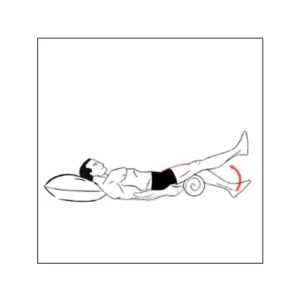
Heel Slide
- Sleep on your back and maintain your legs straight.
- As the knee bends, slowly slide one heel back towards the buttock.
- Then, in reverse, gradually press your heel out until your leg is straight.
- Return to your neutral position after that.
- Then relax.
- 8-10 times per day, repeat this exercise.
- Repeat with the opposite leg.
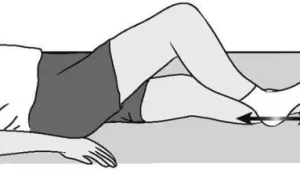
Quadriceps exercises
- Lying or sitting on your back with your back supported and your legs straight out in front of you.
- Pull your feet in towards you and slightly turn your foot out to the side.
- Firmly press your knee down, causing your thigh muscles to contract.
- Maintain this posture for a few seconds.
- Return to your neutral position after that.
- Then unwind.
- 8-10 times per day, repeat this exercise.
- Repeat with the opposite leg.
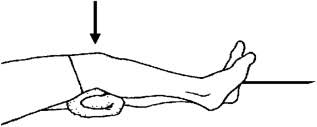
Quadriceps stretch
- For support, sit in a chair or stand close to a wall.
- You should have your feet shoulder-width apart.
- Bring your foot over into your glutes by bending one knee.
- Grab your ankle and pull it as far as you can comfortably towards your glutes.
- For a brief while, maintain this posture.
- Return to your neutral position after that.
- Then relax.
- 8-10 times per day, repeat this exercise.
- Repeat with the opposite leg.

Side-Lying Quadricep Stretch
- Lean to one side.
- By gently pulling with your hand, bend your top leg’s knee as far as you can.
- For a brief while, maintain this posture.
- Then take a position that is neutral.
- Then relax.
- Repeat the exercise while switching legs.
- 8–10 repetitions occur each day.
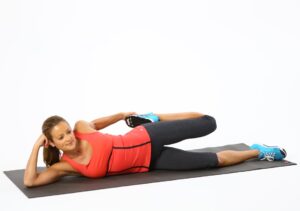
Hamstring stretch
- You can use a mat to place a rolled towel under your knee for this stretch.
- As you lie down on the floor or mat, straighten both legs.
- Put your feet level on the ground and bend both knees if it’s more comfortable.
- Raise one leg off the ground.
- Draw your knee gradually up your chest until you feel a small stretch.
- This shouldn’t be difficult.
- Maintain this posture for a few seconds.
- Change legs by lowering your leg.
- Return to your neutral position after that.
- Then relax.
- Repeat this exercise 8-10 times per day.

Half squat
- In a standing squat, set your feet shoulder-width apart.
- Position your hands in the direction of you or on your hips for balance.
- Do a ten-inch squat, and immediately look straight ahead.
- That’s the center of a full squat.
- Pause for a few moments.
- Then raise yourself by pressing through your heels.
- Return to your neutral position after that.
- Then relax.
- 8-10 times per day, repeat this exercise.
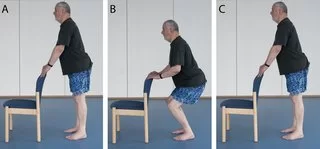
Wall sits
- Standing with your back against a wall, your feet should be about two feet away from the wall and at shoulder width.
- Brace your abs and slowly move your back down the wall once your thighs are aligned with the floor.
- Rather than being over your toes, position your feet such that your knees are squarely above your ankles.
- Maintain a flat back against the wall.
- Maintain the posture for a few seconds.
- Walk back up the wall and stop when you are standing.
- Then return to your neutral position.
- Then relax.
- 8-10 times per day, repeat this exercise.
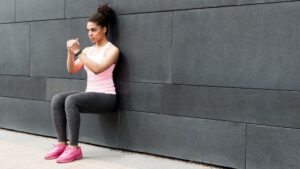
Hamstring curl
- To support, sit in a chair or lean against a wall.
- You should have your feet hip-width apart.
- Raise one foot, bend your knee, and point your heel towards the ceiling.
- With your hips pointing forward and your upper body maintaining still, extend as far as you can.
- Retain this posture for five to ten seconds.
- Lower your leg and relax.
- Return to your neutral position after that.
- Then relax.
- 8-10 times per day, repeat this exercise.
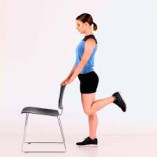
Leg extensions
- Sit up straight in your chair.
- Put your feet on the ground with your hips spaced.
- Look straight ahead, tense your thigh muscles, and raise one leg as high as you can without lifting your buttocks off the ground chair.
- Maintain this posture for a few seconds.
- Change legs by lowering your leg.
- Return to your neutral position after that.
- Then relax.
- 8-10 times per day, repeat this exercise.
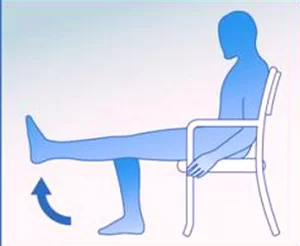
Straight leg raises
- Put one leg bent and the other straight out in front of you while you lay on your back.
- When your straight leg is at the same height as your bent knee, contract your quadriceps and slowly raise it off the ground.
- Pause for 5 seconds at the top, then lower to the starting position.
- Maintain this posture for a few seconds.
- Change legs by lowering your leg.
- Return to your neutral position after that.
- Then relax.
- 8-10 times per day, repeat this exercise.

Side leg raises
- Lying on your side with your legs positioned on top of one another.
- Place one hand on the floor in front of you and cradle your head in the other.
- For strengthening you can use weight.
- Raise your top leg as far as you can comfortably.
- The side of your hips should feel this.
- Maintain this posture for a few seconds.
- Change legs by lowering your leg.
- Return to your neutral position after that.
- Then relax.
- 8-10 times per day, repeat this exercise.

Double Knee To Chest
- Begin on your back with your legs extended out.
- Bring both knees up together and place your hands on the top of the shin below the knee area.
- The back of the thighs is an alternative location for your hands.
- Push your knees slowly towards your chest.
- Maintain this posture for a few seconds.
- Return to your neutral position after that.
- Then relax.
- 8-10 times per day, repeat this exercise.

Unweighted exercises” Leg cycle exercise
- Lay on your back with your legs raised to start.
- For balance, extend both arms out to the sides.
- Start riding with your feet in the air.
- Increase the range of motion in the knee joint area so that the flexion in each leg moves from practically straight and extended to 90 degrees bent.
- Return to your neutral position after that.
- Then relax.
- 8-10 times per day, repeat this exercise.
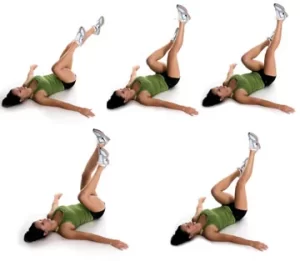
Half-kneeling hip flexor stretch
- Kneel on the floor, flat on your left foot, with your right knee on the floor behind you.
- Maintain a tall posture during this workout.
- For balance, keep your hands on your left knee.
- Slide your right knee back gently until you feel a slight stretch in the front of your hip.
- Push forward with your right glute, bringing your trunk and hips towards your left foot.
- Create a pelvic tilt by tucking your hips slightly.
- Hold this stance for 10-30 seconds after taking a deep breath.
- Return to your neutral position after that.
- Then relax.
- 8-10 times per day, repeat this exercise.
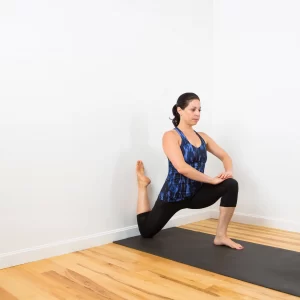
Piriformis stretch
- Begin with your right leg slightly bent and your left leg crossing over the other, as illustrated.
- When the right leg is completely straight upwards and cannot go any higher, hold the back of the right thigh and bring it towards the chest.
- Hold for a total of five seconds.
- Then return to your starting point.
- Then relax.
- Repeat with the other legs.
- If the workout creates extra pain in your sore knee, stop.
- Repeat this exercise 8-10 times per day.
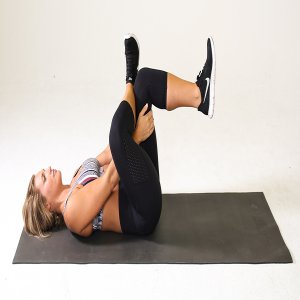
Straight-Leg Piriformis Stretch
- Begin by lying on your back.
- Raise your left leg and cross it over your torso, attempting to contact the ground with your right hand.
- Maintain a flat back and both shoulders on the ground.
- Hold for a total of five seconds.
- Then return to your starting point.
- Then relax.
- Repeat with the other legs.
- For each leg, carry out eight to ten repetitions.
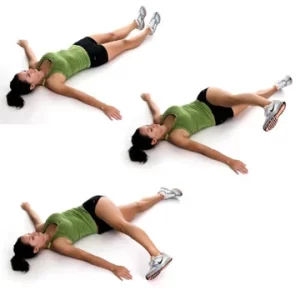
Leg presses
- Bring your knees to your chest while lying on the floor and holding the ends of a resistance band or tubing in each hand.
- Place the tubing across the bottoms of your feet and tighten the resistance band.
- Slowly press both legs outward, leading with your heels, while keeping your elbows on the floor and your hands at your chest.
- You have straight legs.
- Then return to your starting point.
- Then relax.
- Return to a bent-knee stance slowly.
- Rep till you’ve reached your target.
- 8-10 times per day, repeat this exercise.
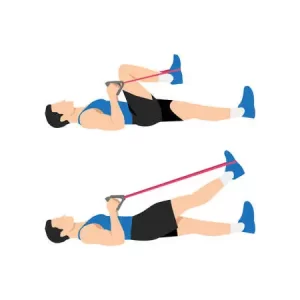
Step-ups
- Stand tall at the bottom of a flight of steps (or step tool made for step workouts) with your feet shoulder-distance apart.
- For stability, grasp the railing or the wall.
- Place your weight on one foot.
- Set your right foot completely on the step and lift your body up onto it, putting your left foot on the stair next to your right foot.
- Return your left foot to the floor slowly and steadily.
- Then return to your starting point.
- Then relax.
- Up until you reach your destination, keep your right foot on the step.
- Repeat on the other side.
- 8-10 times per day, repeat this exercise.

Calf stretch
- Start with a relaxing seating position on the ground.
- Maintain a straight line with your knees.
- A resistance band can be wrapped around the front of your foot.
- Pull your foot back into a slightly flexed position.
- Maintain a flat position with your legs on the floor.
- You can feel your calf muscles stretching.
- Hold for a couple of seconds.
- Return to your neutral position after that.
- Then relax.
- Repeat 8-10 times on the other side.
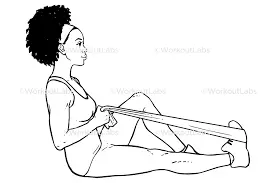
Bridge
- Begin in a comfortable supine position on the table.
- Kneel while placing your feet level on the ground.
- Then, using your bottom muscles, raise your body higher.
- Maintain your arms by your sides.
- Hold for a couple of seconds.
- Reduce your body weight.
- Return to your neutral position after that.
- Then relax.
- Repeat 8-10 times on the other side.

Clamshell exercise
- Begin by lying on your side on the table in a relaxed position.
- Tighten your stomach muscles.
- Bend your knees now.
- Maintain your feet together while bending your top knee.
- Hold for a couple of seconds.
- Then, gradually drop your leg.
- Return to your neutral position after that.
- Then relax.
- Repeat on each side 8-10 times.
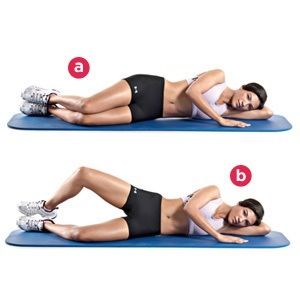
Single Leg Bridge
- Begin by resting flat on your back.
- Extend your arms outwards and place them by your sides.
- Firmly place your feet on the ground while bending your knees.
- Raise your hips to the ceiling while bending your knees to 90 degrees.
- With your heels and the backs of your shoulders, grab the ground.
- Lift one leg straight into the air while maintaining a high hip position.
- Maintain this posture for a few seconds.
- Return to your neutral position after that.
- Then relax.
- Repeat with the other leg.
- Repeat on each side 8-10 times.
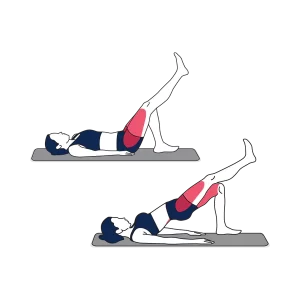
Plank
- As if you were going to do a push-up, position yourself on the ground.
- You can adjust the technique by resting on your forearms (bent) instead of your hands, or by doing a plank from your knees
- Instead of having your entire body extended and supported by your toes.
- Maintain this posture for a few seconds.
- Return to your neutral position after that.
- Then relax.
- Repeat 8-10 times.
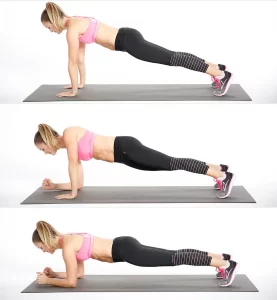
What activities or exercises should you avoid if you have anterior knee pain?
- Continue to exercise to the point of pain, but do not push through it.
- Avoid repetitious tasks till the pain has gone away.
- Walking up and down slopes should be avoided.
- High heels can aggravate the condition by forcing the kneecaps back onto the thigh bones.
- Kneeling and high squatting should be avoided.
- Avoid standing for extended periods of time with your knees locked.
- Swimming breaststroke should be avoided.
What precautions should I take when exercising?
- Avoid strenuous physical exercise.
- Obtain the Correct Balance
- Any workout should be preceded by a warm-up and stretching.
- Stretch and cool down after exercise.
- Maintain proper posture when completing activities.
- Allow your body to rest between times of activity.
- Only use equipment that is properly sized for you.
- Exercise caution and accountability to avoid falls when exercising.
When do you stop working out?
- Severe muscular ache
- You’re contagious.
- If there is any discomfort or numbness.
- Fever
- Headache
- Exercise should be stopped if it hurts.
FAQS
How long will it take for conditions to improve?
Anterior knee discomfort does not have a rapid remedy.
We have a period of rehabilitation.
However, progress can be made further.
Maintaining your specialized exercises is critical to maintaining your gains.
Once you are pain-free, you should continue to complete your workouts, but gently.
Reduce the frequency with which you perform them.
If your symptoms flare up, you should resume your exercises as soon as you are able.
You may have to keep going indefinitely to ensure that your problems do not reoccur.
The majority of people will resume their routine activities, including sports.
Improvements should be expected during the next three to six months.
Can I exercise if I have anterior knee pain?
You can work out while experiencing minor discomfort.
It is advised that discomfort be no more than 3-4/10, that it subsides within one hour of quitting exercising, and that it is not present the next day.
Rest days are essential, and a minimum of one day off following painful activities is recommended.
What variables contribute to anterior knee pain?
Obese people are more likely to suffer from anterior knee pain up to the knee.
Regular exercisers include runners, jumpers, skiers, bicyclists, and football players. People who have had a dislocation, fracture, or other type of damage
How often should someone suffering from anterior knee pain exercise?
You should do at least 20 to 40 minutes of anterior knee pain exercises every day.
You will benefit from a daily stretching and exercise program.
What types of activities are most effective in alleviating the pain and suffering associated with anterior knee pain?
Pillow Push
Terminal knee extension
Quadriceps stretch
Hamstring curl
Hamstring stretch
Half squats
Can exercise aid in the recovery of anterior knee pain?
Exercise is regularly used to alleviate pain and avoid additional harm and suffering.
Stretching is one type of exercise that aids in the strengthening of the body’s supporting muscles.
Regular exercise can help to reduce the frequency of reoccurring discomfort.
What simple home exercises can I do to cure anterior knee pain?
Single leg bridge
Hamstring wall stretch
Calf stretch
Step up
Piriformis stretch
Which workouts should you avoid if you have anterior knee pain?
High-impact exercises might aggravate sore knees.
Avoid jarring movements like lunges and deep squats that put a lot of strain on your knees.
These can aggravate discomfort and, if not used properly, can lead to death.
When done incorrectly, it can result in injury.
Running, jumping, and kickboxing are examples of exercises. Also
What causes anterior knee pain most frequently?
Your knees and feet should always be straight ahead, not bent inside or outward.
As directed by your therapist, you should either stretch out or bend your knees.
Grasp the armrests of a sturdy chair with a straight back.
Avoid using stools, couches, soft chairs, rocking chairs, and low-back chairs following surgery.
How can pain in the knees be avoided?
Even if there is a structural issue, you shouldn’t skip the workout.
Being conscious of your limitations is key.
Whether or not you are active, stretching is good for your knees.
Weight loss can lessen knee pain.
For healthy knees, it’s crucial to wear the right shoes.
To feel better, straighten your posture.

